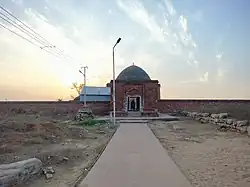Malik Ibrahim Bayu
| Syed Ibrahim Malik Baya | |
|---|---|
 Mausoleum of Malik Ibrahim Bayu in Bihar Sharif | |
| Born | Ghazni, Afghanistan |
| Died | 20 January 1353 CE (13th Dul Hajj 753 AH) Rohtasgarh, Rohtas District, Bihar |
| Clan | Malik |
| Occupation | Military general, Governor |
Ibrahim Malik Baya was a Sufi saint of Suhrawardiyya order and a warrior who arrived in South Bihar, India, in the 14th century and defeated the tribal Kol chiefdoms, who had been oppressing the local Muslims. He was a contemporary of Sharfuddin Yahya Maneri and Muzaffar Shams Balkhi.[1]
He defeated Raja Birthal in a war.[2] Malik Ibrahim Baya's tomb is protected under Archaeological Survey of India and is a tourism spot in Bihar Sharif Nalanda.[3]
History
Malik Baya belonged to Suhrawardiyya order. He came to India during the reign of the sultan Muhammad bin Tughlaq and became commander-in-chief in 1324.
When Malik Baya told Muhammad bin Tughlaq of his first victory over Bihar, the sultan replied: malik biya benasheen (lit. O chief come and sit down).[4]
The sultan sent his general, Syed Ibrahim Malik, to punish Raja Bithal. After a fierce battle, the Raja was killed and his army was defeated. After this conquest of Bihar the sultan have Malik Baya the title of "Madarul Mulk" means Malik or Saif-o-Daulat (Administrator or King of Sword and Wealth).[5]
Malik Baya was also Governor of Bihar and general from 1351 to 1353, during the reign of Sultan Firoz Shah Tughlaq.
Death
Malik Baya died on Sunday, 13th Dul Hajj 753 AH (20 January 1353 AD). He was buried on Peer Pahadi, Bihar Sharif.[1][6][7]
References
- ^ a b Hussain, Syed Amjad. "Malik Ibrahim Baya: A Revered Figure in Bihar's History and Sufi Tradition". New Age Islam. Retrieved 24 August 2024.
- ^ "IBRAHIM BAYA MAQBARA". bt-stage.argildx.com. Archived from the original on 27 October 2021. Retrieved 25 November 2020.
- ^ "Alphabetical List of Monuments – Bihar « Archaeological Survey of India". asi.nic.in. Retrieved 25 November 2020.
- ^ Hanif, N. (2000). Biographical Encyclopaedia of Sufis: South Asia. Sarup & Sons. p. 160. ISBN 978-81-7625-087-0.
- ^ "HISTORY - Syed Mallicks".
- ^ Askari, Syed Hasan (1984). Aspects of the Cultural History of Medieval Bihar. Kashi Prasad Jayswal Research Institute. p. 7.
- ^ Hifz-ur-Rahman, Muhammad (2021). Tazkira-e-Sufiya-e-Bihar (in Urdu). Delhi: Educational Publishing House.
Sources
- [1] from SUFIS OF INDIA PAKISTAN AND BANGLADESH :volume-1 BY Nagendra Kr Singh page no -256
- [2] from Sufi movements in eastern India by Mohammad Yahya Tamizi.page no-199
- [3] from BIOGRAPHICAL ENCYCYCOPEDIA OF SUFIS SOUTH ASIA By N.Hanif ISBN 81-7625-087-2 IN PAGE NO-160.
External links
- Ibrahim Baya Maqbara - Bihar Tourism